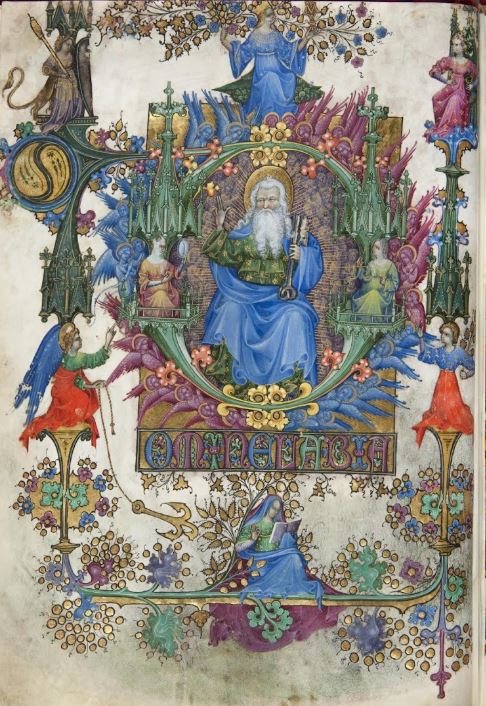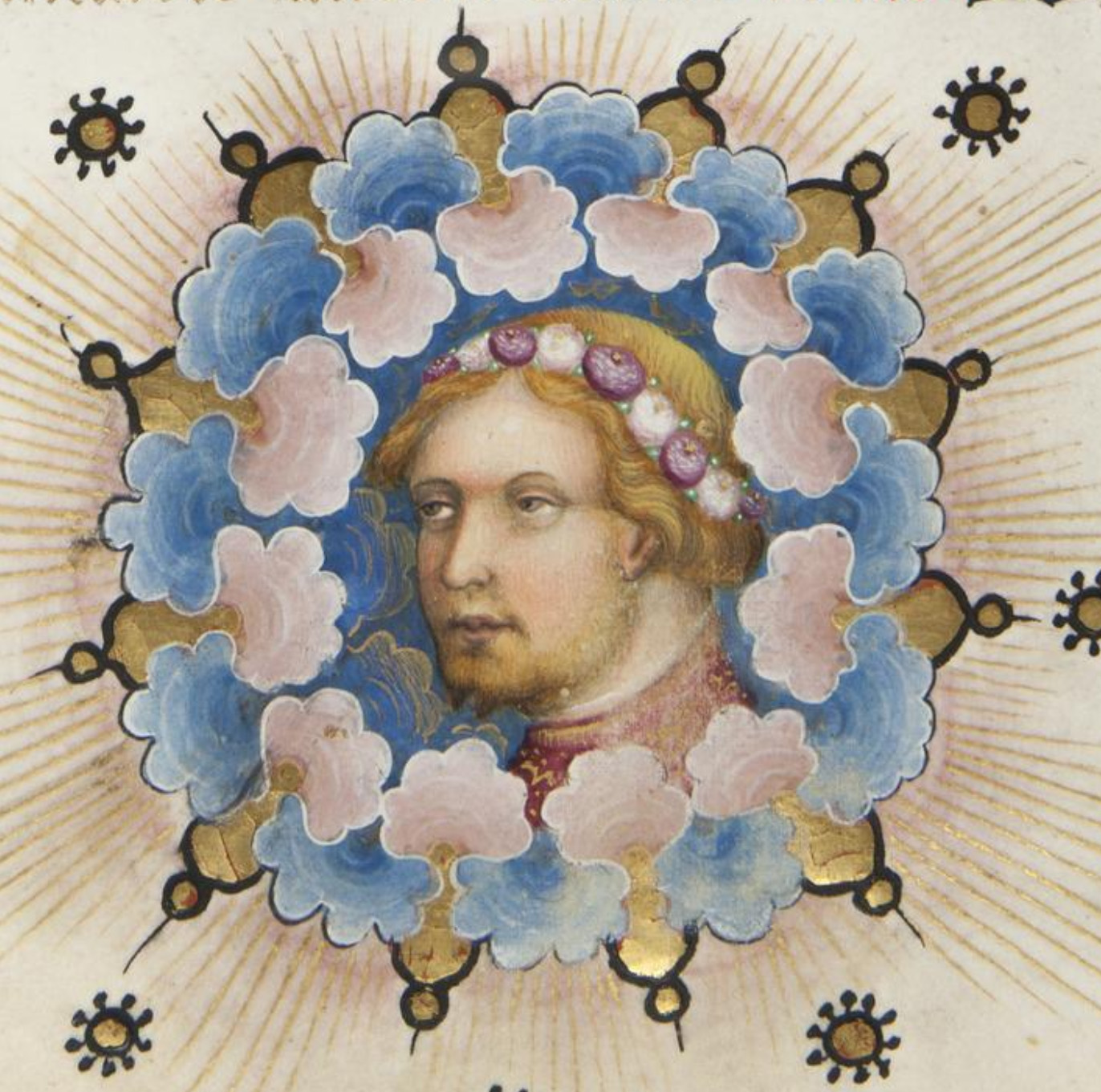With Ross providing the links to hi-res scans of the BR and LF sections of the Visconti Hours I wanted to revisit this speculative post of mine regarding Marziano and the Virtues. Only Ross responded by pointing out the funeral oration/eulogy illumination of Giangaleazzo shows him surrounded by 12 virtues (some courtly ones in addition to the canonical 7 + humility; indeed the included genealogy comes in the eulogy's expansion on the virtue of magnificence). However, the 12 virtues never appear in the Visconti Hours - only the canonical one seven plus humility, in either the Giangaleazzo/BR or Filippo/LF portions.
What is clear is that the 12 virtues were Giangaleazzo's ticket to heaven - seemingly "returning" to his heavenly place, sans purgatory, as "good right" apparently extended into the post-mortem condition. I've also argued previously that the Sun trump in the PMB is partialy a curative for what Filelfo described as Filippo's neglected "funeral rites", and that that many rayed red solar head carried aloft by a cherub is Filippo's soul (the radiant sun being the Visconti symbol after all - the winged dove replaced by a cherub here), the entire ensemble being an approximation of Giangaleazzo's own 'deification' ritual in his eulogy.
But the growing influence of Ciceronian studies (who popularized the Cardinal virtues) in the early Renaissance along with the influence of Aquinas's
Summa, the seven canonical virtues took center stage even in courtly cultures such as the Visconti or Robert the Wise (Angevin) of Naples, and the courtly virtues are seldom found in favor as much as the canonical seven, especially as courtly rulers likened themselves to classical heroes and emperors as classical literature became available in translation. I presume one can already see that influence in the Visconti Hours as there are no courtly virtues. Humility, once literally depicted as the root of all virtues (in the numerous Tree of Virtues in frescoes and manuscripts), herself falls away as Aquinas decides she is merely an aspect of Temperance, except for one exception in the Visconti Hours to be discussed shortly.
I originally proposed a Florentine influence on Marziano, as a conspicuous representation of Humility with the canonical seven was found there:
Phaeded wrote: 23 Apr 2020, 00:56Consider the possible influence of Florence on Marziano in this regard - when he was in Florence Ghiberti's "gates of paradise" on the St. John Baptistery did not yet exist; instead the Andrea di Pizano's bronze doors faced the duomo before getting relocated in 1452. Completed in 1336, these proto-Renaissance doors consist of 28 quatrefoil panels, with the twenty top panels depicting scenes from the life of St. John the Baptist, the eight lower panels depict the eight virtues of hope, faith, charity, humility, fortitude, temperance, justice and prudence. Oddly enough Filippo Visconti was interested enough in this St. John (due to his deceased namesake older brother Giovanni Maria?) to have Filelfo write a life of St. John some years later (Francesco Filelfo, “Prose e poesie volgari di Francesco Filelfo.”
Atti e memorie della Reale deputazione di storia patria per le province delle Marche 5, 1901: 1–261). So perhaps the pivotal location of the Florentine doors and their relationship to a saint of some interest to Filippo contributed to Marziano's idea in overlaying the idea of the virtues, based on Marziano's earlier visit to that cultured city.
While Marziano would have been exposed to that prominent example, I did not consider equally prominent examples closer to home: Two Trecento monumental sculptures - one in Milan dedicated to St. Peter Martyr in the Basilica of Sant'Eustorgio and one in Pavia dedicated to St. Augustine - both have their Gothic edifices supported by the seven virtues plus Humility. They are essentially the same format, with the Pavia virtues attached to engaged pilasters and the Milan one using the virtues as caryatid-like pillars, reproduced below (hard to find the Theos/Humility on-line, below/right is taken from a pic of their casts in London):
The Pavia version:
All fine and well, but did Trecento sculptures - no matter how monumental - mean anything to Filippo? In fact the only appearance of all 8 virtues on the same leaf of the Visconti Hours was on one produced in the section for Filippo by Belbello - what Kirsh/Mesiss call "Celestial Court" which features God holding the keys to heaven while "the angels implore the Deity to allow man to rise from misery to his heavenly home" (Kirsch/Meiss, no #). The virtues, to say it again, are one's "ticket" to salvation (and of course it is the Visconti who exemplify the virtues, nevermind any other account of them). Meiss/Kirsch also caveat the bottom virtue with "may" represent Humility, but she holds the same book in the crowning of Giangaleazzo in his Eulogy (back bottom right virtue), so there is no ambiguity here. I'll also point out she is placed at the bottom of the Hours leaf just as when she was the root in the Tree of Virtues, and sure enough she sits on a leafy limb, on which the other virtues sit as it branches in either direction (albeit vegetation becomes architectural - as it does throughout these hours).

Despite Aquinas, Humility included with seven canonical virtues had not become passe' in Milan by c. 1412, perhaps due to the prominence of such religious orders as the Franciscans.
With the new hi-res images of the Visconti Hours we can view the individual virtues with more detail - Prudence's three faces are now easily recognizable, traces of St. George's red cross on Fortitude's shield can be gleaned, etc. (only Temperance's vessels have been abraded away for the most part):
Regarding Marziano, I had tentatively linked his eight "good" Virtues/Virginities
heroum per this schema (versus the flawed Riches/Pleasures -the antitheses of chaste virtue):
 Marziano virtues-virginities heroum matrix.JPG
Viewed 18895 times 27.84 KiB
Marziano virtues-virginities heroum matrix.JPG
Viewed 18895 times 27.84 KiB
The specific arguments for each virtue can be found further back in this thread in that original post of mine (see time stamp of first quote), but I'd like to revisit the problematic argument made for Pallas:
Pallas - Humility. Relying strictly on Marziano's text, we read "She restrained with remarkable viguor the movements of all sensate pleasures and charms" (35), which is certainly fitting with the modest virtue of Humility. Moreover, all her gifts can be attributed to someone else ("God"), the ultimate act of humility: "...they assert her birth from the head of of Jupiter. And it is right and very fittingly written, because every mode of duty, or political work, and civil business, would seem to have the beginning and birth from Jupiter himself" (ibid). Not much else to go on here and quite frankly humility fell to her because the other three had stronger claims on the Theologicals proper. This seemingly negligible virtue attached to the highest female of the
heroum, needs to be put into context: the presence of humility speaks to the older tradition where that virtue actually was the root of all virtues in Trees of Life - springing from a pot labeled
humilitas, of which Jupiter's head would be the cognate for Pallas (Wisdom, from which all other gifts proceeded), as in this Tree of Life (Beinecke MS 416)
http://brbl-archive.library.yale.edu/ex ... ges/3v.jpg MS 416 begins with a diagram of the Tower of Wisdom, which again points to why Pallas may have been associated with this genre. One might also note Trees of Life, while providing a stemma of the virtues, would parallel the genealogical line also depicted as tree-like, with oak leaves in the case of the Eulogy version of the Visconti line.
What I left out from Marziano, however, perfectly accords with the image of Humility in the hours' leaf: "She is described with
covered head, since the thoughts of philosophers are not readily apparent"(Caldwell/Ponzi, 35). Both Prudence and Justice wear nun-like wimples (Justice's is sheer), perhaps since they are the closest to God, but only Humility has her mantle pulled up over her head. And what is truly unusual here is Pallas is not depicted with a mantle pulled over her head (and blue like Mary's) in the Trecento through the early Quattrocento, as evidenced below in the c. 1340 "Judgement of Paris" produced in the
Regia Carmina by Convenevole da Prato for King Robert of Naples, or in Pizan's
Othea, where the goddess is bifurcated into Minerva and Pallas (as in this luxury manuscript version produced for Queen Isabeau of France in c. 1412):
Finally, I'd point to what seems like a personal connection of Filippo to the virtue of Humility. Ross posted the hi-res detail of Filippo's portrait in the hours, but opposite that leaf, when the book is open, is a continuation of the transference of blame (original sin/generation) to Eve - she holds leaves to her womb out of what might be called humility. What has always bothered me is the pendant image, a child about to stab a lion. Meiss/Kirsch lamely offer the meaning as "power of the duke." I'd rather connect it to the image directly above, which, if Humility, would mean Humility's primary antagonist:
Superbia/Pride. The Tree of Virtues are almost always complemented by a Tree of Vices, and just as Humility is the root of the Virtues, Superbia is the root of Vices. In the Bestiaries that became equally popular, the Lion came to stand for
superbia (and note the smug, smiling face of the Hours' lion). The child then, just like the warrior virtues in Prudentius, is defeating vice, the arch-vice of pride. The enigmatic cape, I would argue, goes hand in hand with the theme of Humility above, now a garment instead of a primitive bunch of leaves. The nude child will be covered after his battle (and arguably the child, whose cape string is red like the coral sometimes hung about the neck of infant Jesus and the cherub of the PMB Sun, is the Christ child offering immortality via Virtue over Vice). The flanking doves as well as the miniature suns with doves would reflect the Holy Spirit, one of which is directly above the child, so all three of the Trinity are represented here.

My conclusion then is that Marziano is making his description of Pallas conform with the imagery of Humility in Milan (not necessarily the specific "Celestial Court" leaf LF11v, but at least a copybook used in Milan artist workshops, which Belbello had recourse to and exemplars of which Marziano had seen; this leaf does come early in the Filippo section so possibly completed early when Marziano was writing so hard to even rule the leaf out as inspiration) .
Phaeded


